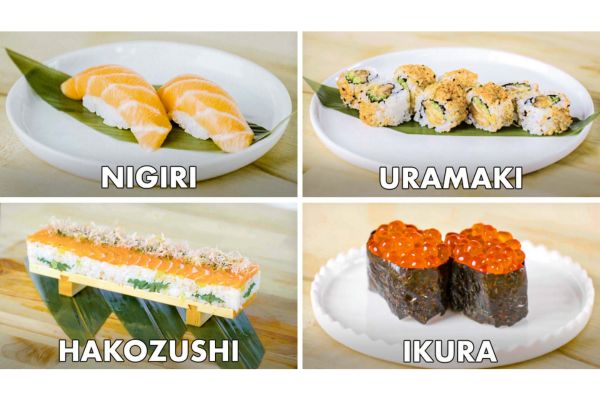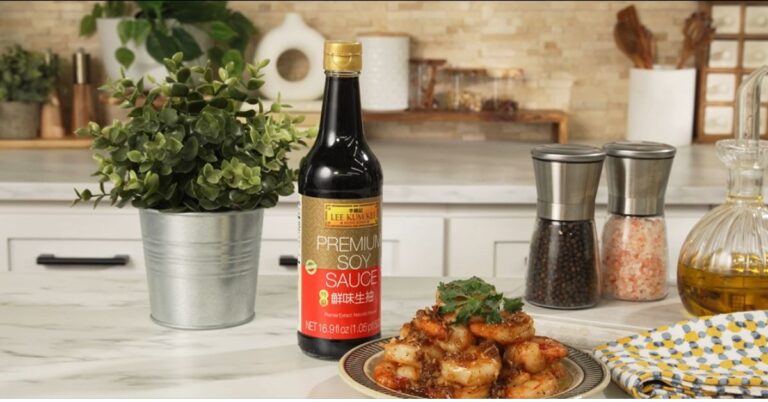Is Sushi Gluten Free? The Real Answer May Surprise You!

Is Sushi Gluten Free? The simple answer to this question is; YES! All traditional and typical sushi or sushi rolls are usually Gluten Free.
Sushi is a popular and the most beloved Japanese cuisine, with vinegared rice either filled or topped with certain ingredients and comes with a variety of sauces.
Are you a celiac or gluten intolerant and a diehard sushi fan too? You usually wonder if sushi is Gluten Free or not. Or can sushi be a go-to partner with your Gluten Free diet?
In this article, we’ll answer your query. So let’s unwrap surprising facts about the Gluten Free status of your beloved cuisine – sushi.
Is Sushi Gluten Free? The Real Answer Inside!
The simple and effortless answer is Yes; a typical or traditional sushi is Gluten Free.
But the problem gets rooted when certain ingredients and sauces are used in sushi and sushi rolls that tarnish their Gluten Free status.
However, if sushi and sushi rolls are made only with raw ingredients, be it any fruits, vegetables or fish, these are all Gluten free.
What You Need to Know About Gluten in Sushi?
Gluten is actually a popular protein that is essentially found in many grains including barley, rye and wheat. So celiac patients, gluten intolerant and gluten sensitive people have to follow a Gluten free diet.
Are you also one of them and wondering if you could have sushi on a Gluten free diet and if Sushi is safe for Celiac?
Yes, if it is a traditional one, it is Gluten Free. As the most obvious ingredients in sushi are Gluten Free, like vegetables, seaweeds, rice, etc.
But there are a number of sushi types that have some other ingredients that bring gluten with them and are not safe for celiac and gluten intolerants.
Is There Any Gluten Source in Sushi?
Now we’ll tell you which sushi ingredients align with your Gluten Free diet and which deviate from it. And at the end, you will also get some pro tips to make your sushi Gluten Free. So let’s start.
Sources of gluten in sushi
Though sushi is traditionally Gluten Free and could be a go-to meal for celiac and non-celiac gluten intolerant, it is not always. There is an abundance of ingredients that could source gluten into your Gluten Free sushi without letting you know.
So, while looking for “Is sushi Gluten Free”, you have to look for ingredients that could bring gluten into your Gluten Free sushi and could trouble your condition.
So here is a look into the sources of gluten in your Gluten Free, much-loved sushi rolls
Sushi Rice
You must be careful about the rice used in your sushi rolls to know about its gluten content.
As answered by Rachel Begun in Answers from a Dietitian: Is Sushi Safe to Eat? who is a well-known registered dietitian, non-distilled white vinegar is used for some of the sushi rice that is usually sourced from wheat or corn.
If such vinegar (wheat-based) is used, then such rice is not Gluten Free. Moreover, sometimes chicken broth containing gluten is also used to prepare sushi rice, hence sourcing gluten into your sushi.
Soy Sauce
Sauces and mainly soy sauce are also a major concern when it comes to Gluten Free sushi for celiac and gluten intolerants.
Mostly soy sauces are prepared with wheat so they have gluten content in them. But don’t worry; there are many amazing and Gluten Free alternatives to soy sauce available, like Gluten Free coconut amino or Gluten Free tamari.
You must be cautious of sushi rolls that have soy sauce in their preparation.
Other Ingredients
If you like “spicy” rolls, wait, do you know that rolls, like spicy salmon or spicy tuna rolls, could contain gluten along with spice? Surprised?
Yes, it is very possible, depending upon their preparation and the ingredients used. For example, the Wasabi version to add spicy taste as popular in the USA, mostly contains gluten if they are not original. To avoid such confusion, don’t forget to ask the chef and the sushi makers to use 100% Gluten Free wasabi.
Imitation crabs are also present in many sushi rolls, again sourcing gluten into your sushi rolls. So make sure if that sushi is Gluten Free or not.
Contamination Via Cross-Contact during Sushi Preparation
In preparation of sushi, cross contamination is of no surprise. If your chef is not changing his tools like knives, cutting boards and gloves while making your Gluten Free sushi, your sushi will no longer be Gluten Free.
You have to discuss your concerns while ordering to customize your Gluten Free sushi.
Types of Sushi: From Nigiri to Maki, Explore Every Sushi Style

Sushi, a widely loved Japanese cuisine comes in different variants all depending upon its preparation methods, ingredients used and sauces it is served with.
Here are the 9 most popular sushi types that are mostly eaten in one or another part of the world and are favorites to many.
If you are a celiac or a gluten-sensitive person, don’t worry. You can also have one after customizing it as per your Gluten Free diet.
Here we go with the most versatile sushi types.
- Nigiri – the most popular type of sushi, thinly sliced raw fish topped with hand-pressed sushi rice
- Inarizushi– a simple sushi dish having fried sweet and salty tofu pouches with stuffed vinegared rice in it
- Makizushi– known as sushi rolls- is filled with a variety of ingredients, from assorted vegetables to raw fish (sashimi)
- Narezushi – Japan’s original fermented sushi- is the traditional type of sushi having fermented rice and salt pickled fish
- Chirashizushi– scattered sushi for occasions mostly served as flavored sushi rice topped by sashimi
- Temarizushi – small and ball shaped sushi especially associated with happy occasions
- Sasazushi – on a bamboo leaf as a plate, sushi rice is presented with wild vegetables
- Gunkan Maki – a common type of sushi usually wrapped in seaweeds
- Oshizushi -coming from Osaka and the successor of narezushi, with fish firmly packed in boxes of fermented rice.
These are the most popular types of sushi. As far as the Gluten Free status of these sushi types is concerned, Celiac and those with gluten intolerance could customize any of them as per their choices.
Some of them are already Gluten Free and for others there are many other alternative ingredients that could be used to retain the Gluten Free status of sushi cuisine.
Essential Tips for Enjoying Safe, Gluten-Free Sushi
People with celiac disease can enjoy sushi for sure. But it’s not as easy as it sounds.
No doubt they can enjoy sushi on the Gluten Free diet, as naturally sushi is Gluten Free but there are fair chances that many restaurants and sushi houses can use cheap or alternative ingredients that could have gluten.
Moreover cross contamination and some basic sauces such as soy sauce could be used that could again source gluten into your Gluten Free sushi.
But don’t worry, here we’re gonna share some pro tips for Celiac and gluten intolerants to have the finest Gluten Free sushi dining experience to carry out their Gluten Free diet.
- Always ask either for Gluten Free soy sauce or tamari
It is the key, as typical soy sauce is not Gluten Free and could ruin your Gluten Free diet. Therefore, you must ask for one. Otherwise, you can carry some packets or sachets in your purse to excel your Gluten Free dining experience.
- Must ask the chef to use clean sushi mats
Usually, in sushi restaurants, chefs roll sushi with other fried items like tempura or crabs that could bring some fried gluten with them. Therefore, you must be cautious about this critical step.
- Never eat Imitation Crabs
As these crabs are not for Celiac and gluten intolerance because of their wheat content.
However, ask for the real crabs as the worthy alternative; in case of unavailability, go for real fish and tuna or ask for other Gluten Free options.
- Asked the sushi chef to use a clean cutting knife and board to avoid cross-contamination
As they cut different sushi rolls with the same knife on the same board hence sourcing cross contamination. Therefore it must be addressed to have a Gluten Free dining experience.
- Avoid gluten-containing dips and sauces with your sushi
There are certain sauces that have soy sauce – a gluten containing sauce, in them, such as nigiri.
Skipping the sauces would be the best option in either case to stay on the safer side. Don’t forget to make sure that the used Rice Vinegar also has no malt in it.
- Order your customized sushi to make sure it’s Gluten Free
Order your own sushi customized as per your need with clear instructions is the key to enjoy Gluten Free dining
Wrapping Up: How to Enjoy Sushi Safely on a Gluten-Free Diet
Yes, sushi in its traditional and classic form is Gluten Free. If you are a celiac or gluten intolerant and also love sushi, don’t worry, you can have any of its popular types.
If the sushi is Gluten Free, well and good, otherwise, you could customize the one as per your Gluten Free diet.
Sushi is a Japanese cuisine that has fish, vinegared rice, seafood, sometimes fruits and certain vegetables. But when sushi comes with wasabi soy sauce and other such ingredients, that puts a question mark on the Gluten Free status of this widely loved dish.
Therefore, for those suffering from celiac disease or non-celiac gluten sensitivity, it is highly suggested to ask for the gluten status of the sushi served.
They must ask the chef to use sterilized cooking tools to avoid any cross-contamination. It would help a lot to enjoy Gluten Free sushi on your Gluten Free dine.
Also Read: Is Hummus Gluten Free?






